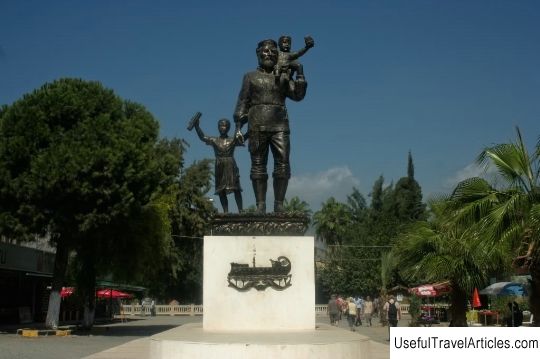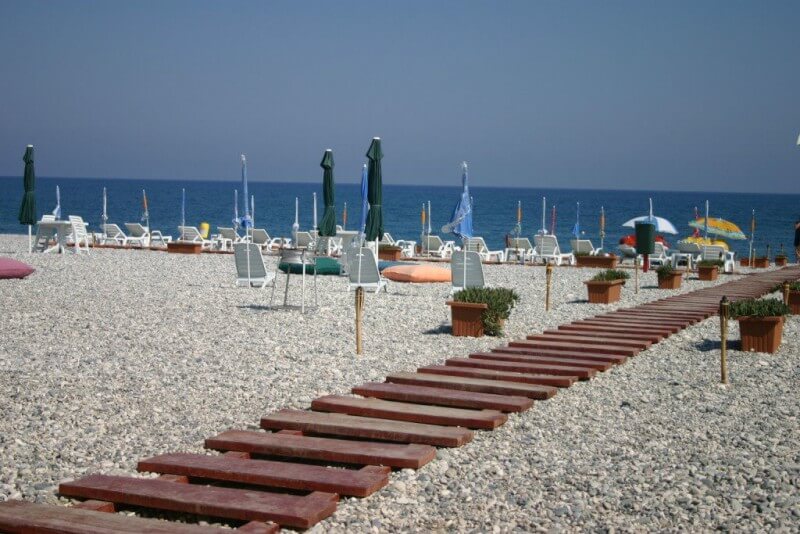Demre (Mira) (Demre) description and photos - Turkey: Antalya
Rating: 8,0/10 (3544 votes) 
Demre (Mira) (Demre) description and photos - Turkey: Antalya. Detailed information about the attraction. Description, photographs and a map showing the nearest significant objects. The title in English is Demre. Photo and descriptionThe ancient city of Myra (the modern name of Demre) is known to us as a place of pilgrimage and holy faith. The city where Nikolai the Wonderworker preached. The exact date of the foundation of the settlement is unknown, but, according to some Lycian inscriptions, it existed as early as the fifth century BC. Myra was one of the largest cities in Lycia and since the reign of Theodosius II was its capital. In the III-II centuries BC, when it was part of the Lycian Union, the city received the right to mint coins. In the first century AD, Emperor Germanicus and his wife Agripina visited Myra, in honor of whose arrival statues of the emperor and empress were erected in the bay of the city. The decline of Mira fell on the seventh century, when the city was destroyed by the Arabs and flooded with the mud of the Miros River. In the early years of Christianity, St. Paul, going to Rome, met here with the first Christians. In the second century, Mira already became the center of the diocese. In 300 AD Nicholas from the city of Patara, known in the Christian world as Saint Nicholas, became Bishop of Myra. He was trained in Xanthus and preached in Mir until his death in 342. Saint Nicholas was buried in an ancient Lycian sarcophagus in a local church. Soon after his death, several miraculous healings took place among the believers who came to worship his ashes. The sick, who came to commemorate the saint, regained their health. Unfortunately, the church in which Nikolai was buried was looted during the Arab raids in 1034. Later, the Byzantine ruler Constantine IX Monomakh and his wife Zoya ordered to build a fortress wall around the temple and transformed the church into a monastery. And in 1087 Italian merchants stole the relics of the saint and transported them to Bari, where Nicholas the Wonderworker was declared the patron saint of the city. According to legend, the Italian monks who opened the sarcophagus with the remains of St. Nicholas smelled the spicy scent of the world. These relics are still in the Cathedral of the city of Bari. Turkey has repeatedly demanded the return of the remains to their historical homeland, but the Vatican reacted very negatively to these demands and the Turkish believers do not yet have much hope of meeting the legal requirements. At the end of the twentieth century, in the church of St. Nicholas in Mira, another grave was found. This find aroused a huge amount of suspicion and speculation about where Nicholas the Wonderworker, Archbishop of Lycia was buried. The Church of St. Nicholas is rightfully considered the third most important religious building of Byzantine architecture in the East. This historical monument has survived to this day in the form of a cruciform basilica, consisting of one large room. The appearance of the temple, which can be observed in our time, the basilica received only in 520. Then, on the site of the ancient Christian temple, a new church was erected and consecrated in honor of St. Nicholas. The church has perfectly preserved icons, frescoes, mosaic floors and a sarcophagus, where, according to the assumption, the imperishable relics of Nicholas the Wonderworker were buried. The floor of the temple is paved with mosaics with geometric patterns of different types of stone and small pieces of smalt. Patterns of small details alternating with large monolithic slabs form a beautiful decorative pattern. This original floor pattern implies that all parts of the mosaic were made according to a preliminary sketch. There is still no exact date when this mosaic pattern was laid on the floor. According to some experts, it existed here even before the service in this church of St. Nicholas the Wonderworker, and later, during the construction of a new building, the floor was included in it. The ruins of the city of Mira are located five kilometers from the coastal strip, between the modern city of Demre and the sea. Fortunately, you can still see the city walls that protected the acropolis from the Hellenistic and Roman periods. The necropolis of the city is located at the top of the cliffs and amazes with a huge number of Lycian rock tombs. Most of the crypts have beautiful facades with inscriptions and excellent reliefs. Each tomb from the outside is decorated very richly and fancifully. If you look closely at the bas-reliefs of the tombs, then, depending on the drawing, you can find out what the deceased did during his lifetime. Many tombs have rich canopies, and the entrances to them are often very similar to small Greek temples or houses with a gable roof supported by pylons. One of these tombs has the shape and facade of a temple, which contains two columns of the Ionian order with capitals and floral ornaments, as well as images of lion heads. The architrave of the frieze has a relief image of a lion attacking a bull. Such a variety and location of tombs can be explained by the ancient custom of the Lycians to bury the dead as high as possible, which was supposed to help the deceased get to heaven faster. An ancient Greco-Roman theater is located very close to the rock tombs, the original architectural ensemble and the beauty of the sculptural bas-reliefs of which speaks of the excellent artistic taste of local masters of that time. The building was built in the second century AD. Its construction was carried out by Lisinus Lanfus from Oinoanda, who was given 10,000 denarii for this. The theater is in relatively good condition. The excellent acoustics of its amphitheater delights the audience to this day. Everything that is said in the orchestra, in front of the first rows of the spectator's seats, is perfectly audible in the very last rows. But, unfortunately, this phenomenon also has an unpleasant effect - the actor himself, performing on the stage, hears multiple echoes of his phrases and this quite hinders his work, because the words of the text are blurred and, as it were, "overlap" each other. The origin of the city's name is also interesting. According to one version, it comes from the word "myrrh", which means the resin from which incense is prepared. According to the second version, the name of the city "Maura" is of Etruscan origin and means "the place of the Mother Goddess", only due to phonetic changes it turned into the World.                    We also recommend reading Church of Santa Eulalia (Igreja de Santa Eulalia) description and photos - Portugal: Braga Topic: Demre (Mira) (Demre) description and photos - Turkey: Antalya. |




